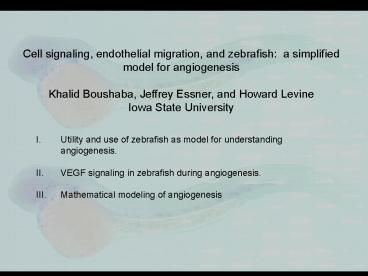Utility and use of zebrafish as model for understanding angiogenesis' - PowerPoint PPT Presentation
1 / 44
Title: Utility and use of zebrafish as model for understanding angiogenesis'
1
Cell signaling, endothelial migration, and
zebrafish a simplified model for
angiogenesis Khalid Boushaba, Jeffrey Essner,
and Howard Levine Iowa State University
- Utility and use of zebrafish as model for
understanding angiogenesis. - VEGF signaling in zebrafish during angiogenesis.
- Mathematical modeling of angiogenesis
2
Cell signaling, endothelial migration, and
zebrafish a simplified model for angiogenesis
3
Zebrafish as a High-throughput Model for
Angiogenesis Research and Therapeutic Development
Large number of offspring Optically clear
embryos Short generation time Small Size
Reverse Genetics Transgenic fish Tilling with
ENU Morpholino injection
Forward Genetics ENU mutagenesis Insertional
mutagenesis
Genomics Sequenced Genome cDNA
projects Microarrays
Small Molecule Screens Predictive of higher
vertebrates Delivery by injection or soaking
Carcinogenesis Aqueous delivery Similar to human
tumors
4
Zebrafish embryos are optically clear and
develop rapidly
From Karlstrom and Kane, 1996
5
Model of Tumor Angiogenesis
From Yancopoulos et al., 2000
Novel Angiogenic Factors
Candidate Anti-Tumor Agents
6
Advantages of Studying Angiogenesis in Zebrafish
Angiogenesis is a conserved vertebrate-specific
function Analysis in living embryos
2.7 dpf
7
Transgenic zebrafish allow analysis of
endothelial cells in living embryos
fli1-egfp transgenic embryo at 2 dpf
Dorsal Longitudinal Anastomotic Vessel (DLAV)
Intersegmental Vessels (Se)
Posterior Cardinal Vein (PCV)
Caudal Vein Capillary Plexus
Dorsal Aorta (DA)
8
Advantages of Studying Angiogenesis in Zebrafish
Microangiography analysis of blood flow in
living embryos
9
The intersegmental vessels form by sprouting
angiogenesis
10
ve-cadherin expression identifies primitive
endothelial cells in the early zebrafish embryo
11
Primary angiogenesis in the trunk and tail are
apparent at 24 hpf ve-cadherin in situ
hybridization
12
Each intersomitic vessel is composed of three
endothelial cells
fli1-egfp transgenic embryo at 2 dpf
13
fli1/gfp embryos allow the behavior of individual
cells to be followed during primary angiogenesis
Movies from Brant Weinsteins lab at the NIH
14
Discovery Genomics, Inc. Karl J. Clark Jon
Larson Aidas Nasevicius Shannon Wadman Perry B.
Hackett Iowa State University Hsin-Kai
Liao Ying Wang Danhua Zhang Katie Lutz
University of Minnesota Eleanor Chen Stephen C.
Ekker Max-Planck Institute - Freiburg Matthias
Hammerschmidt Angiogenetics, AB Mats
Hellstrom
15
Mechanism of Morpholino Phosphoramidate Inhibition
Antisense oligonucleotides Designed as 25
mers Bind tightly Resistant to digestion Low
toxicity Not RNAseH mediated
Inhibition of Translation
Encoded Protein
60S
60S
60S
40S
40S
AUGACCGGUAUUAGUCCGGACCUAGAAAAA
40S
40S
MPO
AUGACCGGUAUUAGUCCGGACCUAGAAAAA
40S
16
Microinjection An Efficient Morpholio Delivery
System
Injection Site
1.5 hrs
4 hrs
0 hr
Easy to perform can inject thousands of embryos
per day
28 hrs
Nasevicius and Ekker (2000, 2001)
17
Microarray Pre-selection vs. Random Selection
Random ENU Mutagenesis screens Genes are mutated
randomly with a chemical mutagen in a forward
genetic screen (Habeck et al., 2002). Subsequent
gene identification is difficult. 0.5 of genes
(approximately 1/200) are estimated to affect
angiogenesis.
SelectedCandidates
Random Screens
0.5
SelectedCandidates
DGI/AG Screen
Discovery Genomics, Inc. /AngioGenetics AB Pilot
Screen Targets were pre-selected basedon
microarray data. 16 of genes (8/50) were
identified as angiogenesis candidates.
16
18
erm1 may associate with Syndecan-2 during
vascular formation to transmit VEGF-signaling
19
Hypothesis I endothelial migration is dependent
on the concentration of VEGF
Migration
VEGF
VEGFR2 (flk1)
20
The embryonic midline influences vasculogenesis
and angiogenesis by inducing VEGF expression
Lawson et al., 2001
21
VEGF is required for the correct number of
endothelial cells ve-cadherin expression
22
Vasculogenesis is dependent on VEGF in zebrafish
embryos
Wt VEGF MO
3 dpf
23
VEGF-A is required for vasculogenesis in zebrafish
Nasevicius et al., 2000
Microangiography allows high resolution mapping
of mature vessels.
24
Migration of the intersegmental vessels is
severely affected in VEGF-A knockdown embryos at
2 dpf
Wt VEGF-A
25
Endothelial migration is dependent on the
concentration of VEGF
Wt VEGF MO
Migration
VEGF
VEGF
VEGFR2 (flk1)
VEGFR2 (flk1)
26
Formation of the intersegmental vessels by
sprouting angiogenesis requires VEGF
Zebrafish ve-cadherin expression at 48 hpf
27
Gradients can be set up and interpreted in many
different ways
Planar transcytosis Argosomes Cytonemes
Restricted diffusion
28
Endothelial migration is dependent on the
concentration of VEGF
Wt VEGF MO VEGF MO hVEGF
Migration
Migration
VEGF
VEGF
VEGF
VEGFR2 (flk1)
VEGFR2 (flk1)
VEGFR2 (flk1)
29
VEGF signaling is conserved during zebrafish
vascular development
VEGF and VEGFR2/flk1
In zebrafish there are two flk1 genes flk1a and
flk1b. Simultaneous knockdown of both flk1a
and flk1b resembles VEGF-A knockdown embryos.
30
Endothelial migration is dependent on the
concentration of VEGF and VEGFR2
wt flk1a and flk1b MO
Migration
VEGF
VEGF
VEGFR2 (flk1)
VEGFR2 (flk1)
31
Syndecan-2, a heparan sulfate-containing
proteoglycan, is essential for angiogenic
sprouting of blood vessels
Syn2 MO, fli-1
WT fli-1
Chen et al., 2004
Syndecan-2 VEGF/VEGFR12
32
Vascular Endothelial Growth Factor A (VEGF-A)
VEGF 121
VEGF 145
VEGF 165
VEGF 183
VEGF 189
VEGF 206
Heparan Sulfate Binding Region
Robinson Stringer, 2001
33
Endothelial migration is dependent on the
concentration of VEGF, VEGFR2, and Syndecan-2
Migration
VEGF
VEGF
Syndecan2 presenting cells
VEGFR2 (flk1)
VEGFR2 (flk1)
34
Syndecan-2 may function in multiple ways
Syndecan-2 Phosphoserine
Growth Factor and Receptor
A Cell-autonomous B Cell-autonomous
Presentation model Complex model C
Cell-nonautonomous, inside-outside signaling
model
35
Endothelial migration is dependent on the
concentration of VEGF
wt VEGF Syn2 MO VEGF MO hVEGF
Migration
Migration
VEGF
VEGF
VEGF
Syndecan2 presenting cells
VEGFR2 (flk1)
VEGFR2 (flk1)
VEGFR2 (flk1)
VEGFR2 (flk1)
36
Ectodomain C1 V
C2 YRMRKKDEGSY DLGERKPSSAAYQKAPTK
EFYA EphB2 PKCg Ezrin
Synbindin Synectin
Syntenin CASK
A Ezrin Synectin F-actin B
C-terminal cytoplasmic domains
HS Chains
Phosphorylation sites Serines and Tyrosines
37
Endothelial migration is dependent on the
concentration of VEGF and VEGF requires Syndecan2
for signaling
Migration
VEGF
Syndecan2 presenting cells
VEGFR2 (flk1)
38
Mass action law
39
(No Transcript)
40
Biochemical equations
41
Role of cell cycle and cell movement equations
42
Cell movement
43
Full model equations
44
(No Transcript)































